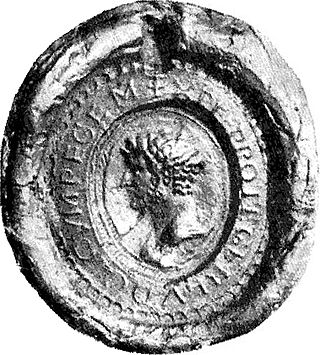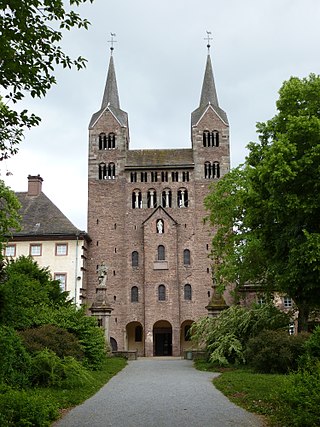
Einhard was a Frankish scholar and courtier. Einhard was a dedicated servant of Charlemagne and his son Louis the Pious; his main work is a biography of Charlemagne, the Vita Karoli Magni, "one of the most precious literary bequests of the early Middle Ages".

Boniface was an English Benedictine monk and leading figure in the Anglo-Saxon mission to the Germanic parts of Francia during the eighth century. He organised significant foundations of the church in Germany and was made bishop of Mainz by Pope Gregory III. He was martyred in Frisia in 754, along with 52 others, and his remains were returned to Fulda, where they rest in a sarcophagus which remains a site of Christian pilgrimage.

Louis the German, also known as Louis II of Germany, was the first king of East Francia, and ruled from 843 to 876 AD. Grandson of emperor Charlemagne and the third son of Louis the Pious, emperor of Francia, and his first wife, Ermengarde of Hesbaye, he received the appellation Germanicus shortly after his death, when East Francia became known as the kingdom of Germany.

An Irminsul was a sacred, pillar-like object attested as playing an important role in the Germanic paganism of the Saxons. Medieval sources describe how an Irminsul was destroyed by Charlemagne during the Saxon Wars. A church was erected on its place in 783 and blessed by Pope Leo III. Sacred trees and sacred groves were widely venerated by the Germanic peoples, and the oldest chronicle describing an Irminsul refers to it as a tree trunk erected in the open air.

The Royal Frankish Annals, also called the Annales Laurissenses maiores, are a series of annals composed in Latin in the Carolingian Francia, recording year-by-year the state of the monarchy from 741 to 829. Their authorship is unknown, though Wilhelm von Giesebrecht suggested that Arno of Salzburg was the author of an early section surviving in the copy at Lorsch Abbey. The Annals are believed to have been composed in successive sections by different authors, and then compiled.

The Princely Abbey of Corvey is a former Benedictine abbey and ecclesiastical principality now in North Rhine-Westphalia, Germany. It was one of the half-dozen self-ruling princely abbeys of the Holy Roman Empire from the Late Middle Ages until 1792 when Corvey was elevated to a prince-bishopric. Corvey, whose territory extended over a vast area, was in turn secularized in 1803 in the course of the German mediatisation and absorbed into the newly created Principality of Nassau-Orange-Fulda. Originally built in 822 and 885 and remodeled in the Baroque period, the abbey is an exceptional example of Carolingian architecture, the oldest surviving example of a westwork, and the oldest standing medieval structure in Westphalia. The original architecture of the abbey, with its vaulted hall and galleries encircling the main room, heavily influenced later western Romanesque and Gothic architecture. The inside of the westwork contains the only known wall paintings of ancient mythology with Christian interpretation in Carolingian times. The former abbey church was listed as a UNESCO World Heritage Site in 2014.

Bruno, also called Brun or Braun, a member of the Ottonian dynasty, was Duke of Saxony from 866 until his death in 880. He is rated as an ancestor of the Brunonids, a cadet branch of the Ottonians, though an affiliation is uncertain. Bruno was killed fighting against Norse warriors in the Battle of Lüneburg Heath and is venerated as one of the Ebsdorf Martyrs.

Leoba, was an Anglo-Saxon Benedictine nun and is recognized as a saint. In 746 she and others left Wimborne Minster in Dorset to join her kinsman Boniface in his mission to the German people. She was a learned woman and was involved in the foundation of nunneries in Kitzingen and Ochsenfurt. She had a leading role in evangelizing the area. Leoba was acclaimed for many miracles: saving a village from fire; saving a town from a terrible storm; protecting the reputation of the nuns in her convent; and saving the life of a fellow nun who was gravely ill – all accomplished through prayer. Her first letter to Boniface contains the first poetry known to have been written by an English woman. |

Anglo-Saxon missionaries were instrumental in the spread of Christianity in the Frankish Empire during the 8th century, continuing the work of Hiberno-Scottish missionaries which had been spreading Celtic Christianity across the Frankish Empire as well as in Scotland and Anglo-Saxon England itself during the 6th century. Both Ecgberht of Ripon and Ecgbert of York were instrumental in the Anglo-Saxon mission. The first organized the early missionary efforts of Wihtberht, Willibrord, and others; while many of the later missioners made their early studies at York.

Hersfeld Abbey was an important Benedictine imperial abbey in the town of Bad Hersfeld in Hesse, Germany, at the confluence of the rivers Geisa, Haune and Fulda. The ruins are now a medieval festival venue.

The Annales Fuldenses or Annals of Fulda are East Frankish chronicles that cover independently the period from the last years of Louis the Pious to shortly after the end of effective Carolingian rule in East Francia with the accession of the child-king, Louis III, in 900. Throughout this period they are a near contemporary record of the events they describe and a primary source for Carolingian historiography. They are usually read as a counterpart to the narrative found in the West Frankish Annales Bertiniani.
Carolingian schools comprised a small number of educational institutions which had a major share in the Carolingian Renaissance, specifically cathedral schools and monastic schools.
Candidus (Bruun) of Fulda was a Benedictine scholar of the ninth-century Carolingian Renaissance, a student of Einhard, and author of the vita of his abbot at Fulda, Eigil.

The Abbey of Fulda, from 1221 the Princely Abbey of Fulda and from 1752 the Prince-Bishopric of Fulda, was a Benedictine abbey and ecclesiastical principality centered on Fulda, in the present-day German state of Hesse.
Ratgar was a controversial abbot at the famous Benedictine monastery of Fulda during the early ninth century.
Gozbald, in Latin Gozbaldus or Gauzbaldus, was the abbot of Niederaltaich from 825, and the bishop of Würzburg from 842, until his death. He also served as chorbishop of the diocese of Passau. On the basis of an entry in the confraternity book of Reichenau Abbey, the historian Gerd Althoff suggests that Gozbald belonged to the Hattonian family.
Janneke Ellen Raaijmakers was a Dutch historian of the Middle Ages who specialized in the formation of monastic communities and the role of religious objects in the cult of the saints, with a particular focus on Fulda and the Fulda monastery, founded by Saint Boniface.
Hadugato or Hathagat was an early Saxon leader, considered a founding father of Saxony by the tenth century. In 531, he led the Saxons to victory over the Thuringians at the battle of Burgscheidungen, "a legendary victory, and one so great that [Hadugato] appeared to [later] Saxons as an epiphany of divinity itself." The Chronica ducum de Brunswick records that in the Duchy of Brunswick in the sixteenth century a memorial week was still observed following Michaelmas to celebrate the Saxon victory over the Thuringians.
Baugulf was a prominent Benedictine abbot in the Carolingian church. He was the second abbot of the Abbey of Fulda in present-day Germany. He served from 779 to 802 CE and was succeeded by Ratgar.
Hathumoda was a Saxon noblewoman who became the first abbess of Gandersheim. Her family, the Liudolfings, founded the Gandersheim Abbey, and she was cloistered since childhood. After she died in an epidemic, there was an unsuccessful attempt to promote her as a saint.











